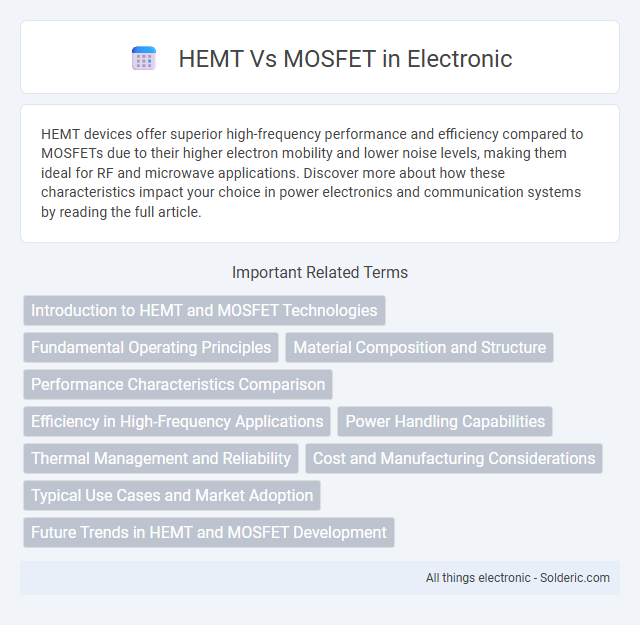HEMT devices offer superior high-frequency performance and efficiency compared to MOSFETs due to their higher electron mobility and lower noise levels, making them ideal for RF and microwave applications. Discover more about how these characteristics impact your choice in power electronics and communication systems by reading the full article.
Comparison Table
| Parameter | HEMT (High Electron Mobility Transistor) | MOSFET (Metal-Oxide-Semiconductor Field-Effect Transistor) |
|---|---|---|
| Material | Compound semiconductors (e.g., GaAs, GaN) | Silicon (Si) |
| Electron Mobility | High (due to 2D electron gas) | Lower than HEMT |
| Operating Frequency | Up to THz range (high-frequency) | Lower, up to GHz range |
| Power Efficiency | High efficiency at RF and microwave frequencies | Moderate efficiency |
| Applications | RF amplifiers, microwave circuits, 5G, radar | General switching, digital circuits, power electronics |
| Gate Structure | Schottky gate (metal-semiconductor junction) | Oxide-insulated gate |
| Switching Speed | Very high | High, but lower than HEMT |
| Thermal Conductivity | Better in wide bandgap materials like GaN | Standard silicon thermal properties |
| Cost | Higher due to compound semiconductor materials | Lower, mature silicon technology |
Introduction to HEMT and MOSFET Technologies
HEMT (High Electron Mobility Transistor) and MOSFET (Metal-Oxide-Semiconductor Field-Effect Transistor) are advanced semiconductor technologies used for high-speed and high-frequency applications. HEMTs utilize a heterojunction interface to achieve superior electron mobility, enabling enhanced performance in microwave and RF devices, while MOSFETs operate based on voltage-controlled conduction through an oxide-insulator layer, making them essential in digital and power electronics. Understanding the fundamental differences in their structures and operating principles helps optimize your circuit design for specific high-frequency or switching applications.
Fundamental Operating Principles
High Electron Mobility Transistors (HEMTs) utilize heterojunctions between different semiconductor materials to create a two-dimensional electron gas with exceptionally high mobility, enabling faster switching speeds and higher frequency operation compared to Metal-Oxide-Semiconductor Field-Effect Transistors (MOSFETs). MOSFETs operate by modulating the conductivity of a channel through an electric field applied via a metal gate insulated from the semiconductor by an oxide layer, relying on electron flow in a bulk semiconductor material. The distinct material interfaces and charge carrier dynamics in HEMTs provide superior electron velocity and reduced noise, making them ideal for microwave and RF applications, whereas MOSFETs excel in digital circuitry due to their well-established fabrication processes and scalability.
Material Composition and Structure
HEMTs (High Electron Mobility Transistors) utilize compound semiconductor materials such as GaAs or GaN combined with AlGaN to form a heterojunction, creating a two-dimensional electron gas (2DEG) for high-speed electron mobility and low noise performance. MOSFETs (Metal-Oxide-Semiconductor Field-Effect Transistors) are primarily based on silicon with a single semiconductor channel and an insulating oxide layer (SiO2) that controls the gate. The heterojunction structure of HEMTs provides superior electron velocity and efficiency compared to the bulk silicon channel of MOSFETs, making HEMTs ideal for high-frequency and high-power applications.
Performance Characteristics Comparison
HEMTs (High Electron Mobility Transistors) exhibit superior performance in high-frequency and high-power applications due to their higher electron mobility and faster switching speeds compared to MOSFETs (Metal-Oxide-Semiconductor Field-Effect Transistors). While MOSFETs offer better compatibility with integrated circuits and cost-effectiveness, HEMTs outperform them in low-noise amplification and efficiency at microwave frequencies. Your choice depends on whether high-speed, high-frequency operation or integration and cost considerations are more critical for your application.
Efficiency in High-Frequency Applications
HEMTs (High Electron Mobility Transistors) outperform MOSFETs in high-frequency applications due to their superior electron mobility and lower parasitic capacitances, resulting in higher efficiency and faster switching speeds. The inherent design of HEMTs allows for reduced power loss and improved thermal management under high-frequency conditions, making them ideal for RF amplifiers and microwave circuits. Your high-frequency systems benefit from HEMT technology by achieving better signal integrity and energy savings compared to traditional MOSFETs.
Power Handling Capabilities
HEMTs (High Electron Mobility Transistors) exhibit superior power handling capabilities compared to MOSFETs due to their high electron mobility and lower on-resistance, making them ideal for high-frequency and high-power applications. MOSFETs typically face limitations in power density and thermal resistance, which can hinder performance under extreme power conditions. Understanding these differences can help you select the right transistor technology for optimizing power efficiency and device reliability.
Thermal Management and Reliability
HEMT devices exhibit superior thermal conductivity and higher thermal stability compared to MOSFETs, enabling efficient heat dissipation under high-power conditions. The wide bandgap semiconductor materials used in HEMTs, such as GaN or AlGaN, contribute to enhanced reliability and reduced thermal-induced performance degradation. MOSFETs, often based on silicon, face more pronounced limitations in thermal management, making HEMTs preferable for high-frequency, high-temperature applications.
Cost and Manufacturing Considerations
HEMTs generally have higher manufacturing costs compared to MOSFETs due to complex epitaxial growth and precise fabrication processes involving III-V materials like GaN or GaAs. MOSFETs benefit from mature silicon-based manufacturing infrastructure, which results in lower production costs and greater scalability for mass production. When considering your application's budget constraints, MOSFETs often present a more cost-effective solution, but HEMTs offer superior performance in high-frequency or power applications despite the higher manufacturing expenses.
Typical Use Cases and Market Adoption
HEMTs are predominantly used in high-frequency applications such as RF amplifiers, satellite communications, and 5G technology due to their superior electron mobility and high power efficiency. MOSFETs dominate power electronics and digital circuits, benefiting from widespread manufacturing infrastructure and cost-effectiveness for switching and amplification tasks. Market adoption favors MOSFETs in consumer electronics and automotive systems, while HEMTs carve a niche in specialized high-frequency and microwave industries.
Future Trends in HEMT and MOSFET Development
Future trends in HEMT and MOSFET development emphasize enhancing power efficiency and switching speed to meet growing demands in high-frequency and high-power applications. Advances in material science, such as incorporating GaN and SiC in HEMTs, aim to improve thermal performance and breakdown voltage, surpassing traditional silicon MOSFET limits. Your choice between HEMT and MOSFET technology will increasingly depend on balancing performance requirements with cost and integration capabilities in emerging electronic systems.
HEMT vs MOSFET Infographic

 solderic.com
solderic.com